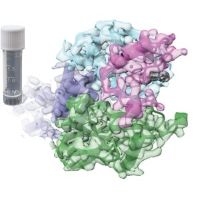Specification
| Description | Recombinant protein from the full-length sequence of Homo sapiens MNAT1 component of CDK activating kinase (MNAT1), transcript variant 1 (NM_002431). |
| Organism | Homo sapiens (Human) |
| Expression Host | Human Cells |
| Tag Info | His or DYKDDDDK. Please contact us if you need further information or require specific designed tag. |
| Purity | Greater than 90% by SDS-PAGE gel |
| Uniprot ID | P51948 |
| Entry Name | MAT1_HUMAN |
| Gene Names | MNAT1 CAP35 MAT1 RNF66 |
| Alternative Gene Names | CAP35 MAT1 RNF66 |
| Alternative Protein Names | CDK-activating kinase assembly factor MAT1 (CDK7/cyclin-H assembly factor) (Cyclin-G1-interacting protein) (Menage a trois) (RING finger protein 66) (RING finger protein MAT1) (p35) (p36) |
| Application | Antigens, Western, ELISA and other in vitro binding or in vivo functional assays, and protein-protein interaction studies; For research & development use only! |
| Buffer | Purified protein formulated in a sterile solution of PBS buffer, pH7.2, without any preservatives |
| Endotoxin | Endotoxin level is < 0.1 ng/µg of protein (<1EU /µg) |
| Length | 309 |
| Molecular Weight(Da) | 35823 |
| Protein Sequence | (The sequence of expressed protein may have some variation from the sequence shown below. Please contact us for the exact sequence.) MDDQGCPRCKTTKYRNPSLKLMVNVCGHTLCESCVDLLFVRGAGNCPECGTPLRKSNFRVQLFEDPTVDKEVEIRKKVLKIYNKREEDFPSLREYNDFLEEVEEIVFNLTNNVDLDNTKKKMEIYQKENKDVIQKNKLKLTREQEELEEALEVERQENEQRRLFIQKEEQLQQILKRKNKQAFLDELESSDLPVALLLAQHKDRSTQLEMQLEKPKPVKPVTFSTGIKMGQHISLAPIHKLEEALYEYQPLQIETYGPHVPELEMLGRLGYLNHVRAASPQDLAGGYTSSLACHRALQDAFSGLFWQPS |
Background
| Function | FUNCTION: Stabilizes the cyclin H-CDK7 complex to form a functional CDK-activating kinase (CAK) enzymatic complex. CAK activates the cyclin-associated kinases CDK1, CDK2, CDK4 and CDK6 by threonine phosphorylation. CAK complexed to the core-TFIIH basal transcription factor activates RNA polymerase II by serine phosphorylation of the repetitive C-terminal domain (CTD) of its large subunit (POLR2A), allowing its escape from the promoter and elongation of the transcripts. Involved in cell cycle control and in RNA transcription by RNA polymerase II. {ECO:0000269|PubMed:10024882}. |
| Pathway | |
| Protein Families | |
| Tissue Specificity | Highest levels in colon and testis. Moderate levels are present thymus, prostate, ovary, and small intestine. The lowest levels are found in spleen and leukocytes. |
QC Data
| Note | Please contact us for QC Data |
| Product Image (Reference Only) |  |

